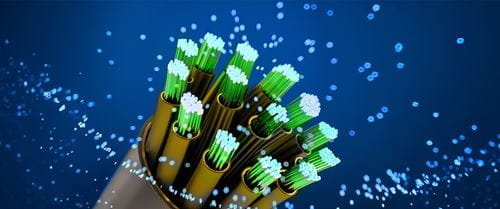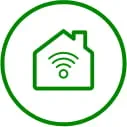As our world becomes more connected, having a fast and reliable home internet connection is more important than ever. Whether you're streaming movies, working remotely, gaming or running a smart home, the type of internet you choose can significantly impact your experience. While several internet options exist—DSL, satellite and fixed wireless—fiber and cable stand out as the most viable choices for modern households. But how do they differ, and which one is best for you in 2025? Let's break it down.
How internet actually reaches your home
To understand the differences between Ziply Fiber and cable, it helps to know how the internet actually gets to your home.
- Cable internet relies on coaxial cable lines—the same ones used for cable TV—to deliver internet service. These cables transmit data using electrical signals.
- Fiber internet uses fiber-optic cables made of glass strands that transmit data using light signals, allowing for much faster and more reliable connections.
This fundamental difference in technology affects everything from speed to reliability.
Speed
Speed is one of the biggest factors people consider when choosing an internet provider, and fiber internet has a clear advantage over cable.
- Download vs. upload speeds: Most cable internet plans have fast download speeds but significantly slower upload speeds. Fiber internet, on the other hand, offers symmetrical speeds, meaning you get equally fast downloads and uploads.
- Why upload speeds matter: In 2025, with video calls, cloud storage and online gaming becoming even more important, having fast upload speeds is essential. Fiber internet's symmetrical speeds make it a superior choice for remote workers, content creators and anyone who shares large files online.
Reliability
Beyond speed, reliability is a crucial consideration.
- Network congestion: Because cable internet operates on shared infrastructure, speeds often slow down during peak usage hours when many people in your neighborhood are online. Fiber internet provides a dedicated connection that doesn't experience the same slowdowns.
- Durability & maintenance: Fiber-optic cables are more resistant to weather, electromagnetic interference and signal degradation over long distances, making them a more stable and reliable choice.
Cost
While fiber internet used to be considered more expensive, that gap has significantly narrowed.
- Cable bundles vs. standalone fiber internet: Many cable providers push customers into bundled packages with TV and phone services, which can add to overall costs. Fiber internet is typically offered as a standalone service, allowing customers to pay only for what they need. It's also worth noting that, because cable internet is an older technology, there can be more maintenance costs incurred by the provider, which they will pass along to their customers
- Long-term value: While fiber internet may have a slightly higher upfront cost, its superior performance, reliability and potential for fewer service interruptions make it a better long-term investment.
Installation
Understanding what's involved in getting internet installed can help you prepare for the switch.
- Cable internet installation: If your home has a coaxial connection, setup is fairly basic and quick—though limited by older infrastructure.
- Fiber internet installation: Fiber internet requires the installation of specialized fiber-optic lines to your home, which may take longer, but the benefits in speed and reliability make it worth the wait.
Future-proofing your home
The internet needs of today won't be the same as tomorrow, making it crucial to choose a technology that can keep up.
- Growing bandwidth demands: With 8K streaming, cloud gaming and VR applications becoming more common, fiber internet's higher bandwidth capacity ensures your home is ready for the future.
- Smart home compatibility: More homes are integrating smart devices, from security cameras to voice assistants. A fiber internet connection ensures seamless operation for all these connected devices.
- Work-from-home & education: The shift toward remote work and online learning means having a fast, stable internet connection is more important than ever. Fiber internet's reliability and symmetrical speeds make it the best choice for video conferencing and real-time collaboration.
Availability
While fiber-optic coverage is expanding rapidly, it's still not as widely available as cable in some regions.
- Current coverage maps: While cable internet has been around longer, fiber internet networks are growing. Companies like Ziply Fiber are leading the charge in expanding fiber internet access to more communities.
- Ziply Fiber's expansion initiatives: We're committed to bringing fiber internet to more homes and businesses across the Northwest, ensuring that more people can experience the benefits of next-generation connectivity.
- How to check availability: To see if fiber internet is available in your area, visit our website and enter your address.
Making the switch
If you're ready to move from cable to fiber internet, here's what you can expect:
- Check availability — use our online tool to see if fiber internet is available in your neighborhood.
- Choose your plan — select a fiber internet plan that fits your speed and usage needs.
- Schedule installation — our professional technicians will set up your fiber internet connection and ensure everything runs smoothly.
- Enjoy faster, more reliable fiber internet — once installed, experience the difference with ultra-fast speeds, better reliability and no more network congestion.
The choice is clear, and really fast
While both cable and fiber internet offer broadband connectivity, fiber internet stands out as the superior choice in almost every category—speed, reliability, future-proofing and overall value. If you want an internet connection that can keep up with your needs today and in the future, fiber internet is the way to go.
Ready to make the switch? Check if Ziply Fiber is available in your area today.






